Electronegativity Study guides, Class notes & Summaries
Looking for the best study guides, study notes and summaries about Electronegativity? On this page you'll find 1196 study documents about Electronegativity.
Page 4 out of 1.196 results
Sort by
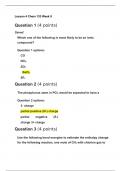
-
CHEM133 Week 9 Lesson 4 Quiz Questions and Answers APU
- Exam (elaborations) • 12 pages • 2023
- Available in package deal
-
- $23.99
- + learn more
1. Question: Which one of the following is most likely to be an ionic compound? 2. Question: The phosphorus atom in PCl3 would be expected to have a 3. Question: The phosphorus atom in PCl3 would be expected to have a give CH3Cl and hydrogen chloride. 4. Question: How many of the following molecules have no dipole moment? 5. Question: Atoms having equal or nearly equal electronegativities are expected to form 6. Question: Element A has an electronegativity of 0.8 and element B has an electr...
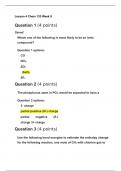
-
CHEM133 Week 9 Lesson 4 Quiz
- Exam (elaborations) • 12 pages • 2023
- Available in package deal
-
- $31.66
- + learn more
1. Question: Which one of the following is most likely to be an ionic compound? 2. Question: The phosphorus atom in PCl3 would be expected to have a 3. Question: The phosphorus atom in PCl3 would be expected to have a give CH3Cl and hydrogen chloride. 4. Question: How many of the following molecules have no dipole moment? 5. Question: Atoms having equal or nearly equal electronegativities are expected to form 6. Question: Element A has an electronegativity of 0.8 and element B has an electr...
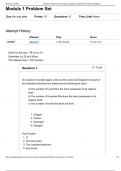
-
CHEM 219 Module 1 Problem Set: Principles of Organic Chemistry with Lab FALL 2023 Portage learning
- Exam (elaborations) • 18 pages • 2023
-
- $22.49
- + learn more
On a piece of scratch paper, write out the Lewis Dot Diagram for each of the indicated elements and determine the following for each: a) The number of Lone Pairs the atom possesses in its valence shell. b) The number of Unpaired Electrons the atom possesses in its valence shell. c) The number of bonds the atom will form. 1. Oxygen 2. Carbon 3. Hydrogen 4. Nitrogen 1. O 2. Two lone pairs 3. Two unpaired electrons 4. two bonds 12/14/23, 8:42 PM Module 1 Problem Set: Principles of Or...
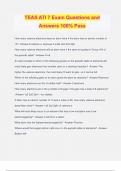
-
TEAS ATI 7 Exam Questions and Answers 100% Pass
- Exam (elaborations) • 18 pages • 2024
-
- $12.49
- + learn more
TEAS ATI 7 Exam Questions and Answers 100% Pass How many valence electrons does an atom have if the atom has an atomic number of 10? -Answer-8 valence e- because it ends with 2s2 2p6 How many valence electrons will an atom have if the atom is located in Group VIA of the periodic table? -Answer-VI=6 An atom located in which of the following groups on the periodic table of elements will most likely gain electrons from another atom in a chemical reaction? -Answer-The higher the valence elec...
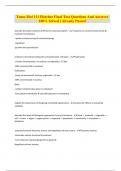
-
Tamu Biol 111 Fletcher Final Test Questions And Answers 100% Solved | Already Passed
- Exam (elaborations) • 33 pages • 2024
-
- $9.49
- + learn more
describe the basic functions all life forms must accomplish - -response to environmental stimuli & maintain homeostasis -uptake and processing of nutrients/energy -regulation -growth and reproduction compare and contrast eukaryotic and prokaryotic cell types - Prokaryotes: -circular chromosomes, no nucleus, no organelles, 3.5 bya -DNA concentrated in nucleoid Eukaryotes: -linear chromosomes, nucleus, organelles, 1.5 bya -DNA concentrated in nucleus Both: -cellular function takes plac...
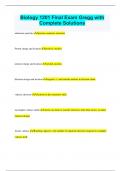
-
Biology 1201 Final Exam Gregg with Complete Solutions
- Exam (elaborations) • 31 pages • 2024
- Available in package deal
-
- $10.49
- + learn more
Biology 1201 Final Exam Gregg with Complete Solutions subatomic particles protons, neutrons, electrons Proton charge and location positive, nucleus neutron charge and location neutral, nucleus Electron charge and location negative (-) and outside nucleus in electron cloud valence electrons electrons in the outermost shell incomplete valence shells atoms can share or transfer electrons with other atoms, or make chemical bonds Atoms valence Bonding capacity = the number of...
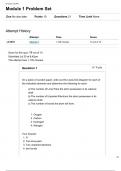
-
CHEM 219 Module 1 Problem Set Principles of Organic Chemistry with Lab Gallaher Portage Learning.
- Exam (elaborations) • 18 pages • 2024
- Available in package deal
-
- $11.99
- + learn more
CHEM 219 Module 1 Problem Set Principles of Organic Chemistry with Lab Gallaher Portage Learning. Score for this quiz: 10 out of 10 Submitted Jul 25 at 8:42pm This attempt took 1,135 minutes. Question 1 0 / 0 pts Your Answer: On a piece of scratch paper, write out the Lewis Dot Diagram for each of the indicated elements and determine the following for each: a) The number of Lone Pairs the atom possesses in its valence shell. b) The number of Unpaired Electrons the atom possesses in its...
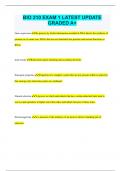
-
BIO 210 EXAM 1 LATEST UPDATE GRADED A+
- Exam (elaborations) • 11 pages • 2024
- Available in package deal
-
- $9.99
- + learn more
BIO 210 EXAM 1 LATEST UPDATE GRADED A+ Gene expression the process by which information encoded in DNA directs the synthesis of proteins or; in some case, RNAs that are not translated into proteins and instead functions as RNAs Ionic bonds Bonds that require donating and accepting electrons Emergent properties Properties of a complex system that are not present within its parts but that emerge only when those parts are combined. Natural selection A process in which individuals ...
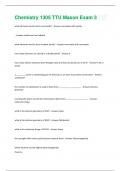
-
Chemistry 1305 TTU Mason Exam 3 Questions and Answers(A+ Solution guide)
- Exam (elaborations) • 4 pages • 2024
- Available in package deal
-
- $7.99
- + learn more
what elements tend to form ionic bonds? - Answer-nonmetals with metals - Answer-metals and non labeled what elements tend to form covalent bonds? - Answer-nonmetals with nonmetals how many electrons are shared in a double bond? - Answer-4 how many valence electrons does Nitrogen have and how any bonds can it form? - Answer-5 VA, 3 bonds a ________ can be a nonbonding pair of electrons or an atom around the central atom - Answersubstituent the number of substituents is used to determine __...
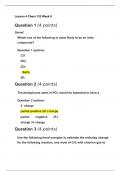
-
CHEM133 Week 9 Lesson 4 Quiz
- Exam (elaborations) • 12 pages • 2023
-
- $32.49
- + learn more
1. Question: Which one of the following is most likely to be an ionic compound? 2. Question: The phosphorus atom in PCl3 would be expected to have a 3. Question: The phosphorus atom in PCl3 would be expected to have a give CH3Cl and hydrogen chloride. 4. Question: How many of the following molecules have no dipole moment? 5. Question: Atoms having equal or nearly equal electronegativities are expected to form 6. Question: Element A has an electronegativity of 0.8 and element B has an electr...

That summary you just bought made someone very happy. Also get paid weekly? Sell your study resources on Stuvia! Discover all about earning on Stuvia


